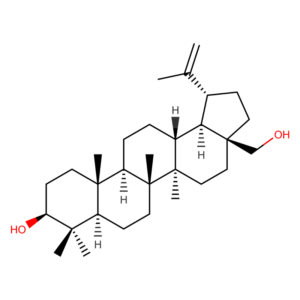Extraction and Isolation of Betulin

From folk medicine it is known, that birch bark can be used to treat several kinds of skin diseases. Research shows, that most of its activity is regarded to betulin and its derivatives. Betulin is a naturally occurring pentacyclic triterpenoid, which is most commonly found in the family of Betulaceae (that includes birch and hazel trees). To further explore this compound isolation is a crucial part of the research. In order to isolate this compound, which comprises up to 30% of birch bark dry mass, several methods of extraction and isolation of betulin have been developed.
Betulin is known since 1788 when Johann Tobias Lowitz first isolated it from bark by sublimation. Betulin and betulinic acid (betulin acid) can be observed as secondary metabolites in more than 200 different plants (doi: 10.1016/B978-0-444-63930-1.00002-8). But as previously mentioned birch bark is the main way to
produce such kinds of compounds. Belong side betulin, the white outer part of birch bark contains not only betulin and betulinic acid, but other metabolites as well – betulin aldehyde, methylester etc (link). Such a wide variety of similar compounds makes extraction of betulin and betulinic acid quite a challenging job. In recent years, there have been developed several methods for obtaining it.
Methods for isolation
The most common way to get betulin is solid-liquid extraction with organic solvents – ethanol, methanol, n-hexane, ethyl acetate, dichloromethane, etc. An effective way to improve the extraction process is to activate bark with water vapor in presence of sodium hydroxide. Further, this activation is followed by the use of organic solvent. The method developed using a mixture of ethyl acetate/ethanol/water in presence of sodium or potassium hydroxide allowed to obtain extract where the content of betulin was from 74-75% and 85-89% respectively (DOI: 10.3390/molecules17089274).
More advanced methods include betulin extraction using microwave-assisted extraction with limonene. Such a method allowed to obtain betulin in high purity (DOI: 10.1039/C3RA43868F).
Using subcritical water extraction, it is possible to extract betulinic acid (betulin acid) from birch bark in high purity. It is possible to obtain 28 mg from 10 g of bark in half an hour (DOI: 10.1016/j.indcrop.2015.05.064).
Recent investigations show the use of wet ethylacetate in presence of microwaves. Work up of such extract with different types of stable monoterpenes, limonene, pinene or etc. allowed to obtain betulin with 95-97% purity with high yields. Such a method is also green and economical as it is possible to recover up to 85% of used solvents (DOI: 10.1021/acssuschemeng.8b00086).
For your convenience, not to extract these compounds yourself, you can check out our store for betulin and betulin derivatives.



